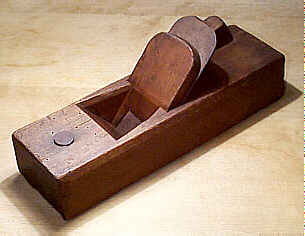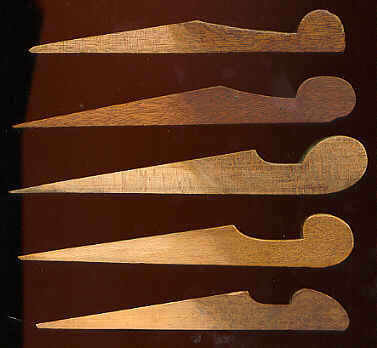
A focused, dedicated, and small area of tool collecting is the 18th century planes. Apart from the age of these planes, many collectors are passionate about them for the simple fact that their style of construction reflects regional methods, allowing a glimpse of each maker's individualism. Like so many other trades of the time, the Master-Apprentice relationship also manifests itself in the planemaking trade where it's possible to trace the influence of the master through his student's work.
The American planemakers, particularly those working their trade in New England, exhibit a true style of individualism that almost seemingly was a harbinger of greater and better things to come as the century progressed. It's as if the Yankee planemaker purposely turned his back on the designs of his motherland, arriving at a design that can be found nowhere else.

American planemaking has its roots firmly planted in New England and nowhere more so than the southeastern area of Massachusetts centered around the sleeply town of Wrentham. It's here in Wrentham where America's first documented planemaker, Francis Nicholson (b. 1683, d. 1753), started to imprint his planes almost as if by spontaneous generation. Certainly, others were making planes here in the colonies, but Francis is generally credited with being the first professional to mark his planes in the curious fashion of three separate stamps (when space enough permitted): F*NICHOLSON / LIVING*IN / WRENTHAM. An example of Nicholson's work, a 3" wide blade cornice plane, is pictured to the right.
One might think it a rare event to uncover a wooden plane made by Nicholson, but such is not the case. Nicholson was a prolific maker and was really the Stanley of his day. He and his slave, Cesar Chelor, must have turned out tens of thousands of planes during the working period of 1728 (when Nicholson settled in Wrentham) to 1753. Today, there are litterally hundreds of Nicholson's planes that have survived the ravages of use, misuse, fire, and wood-eating insects and fungi. Despite their numbers, they still command a premium for the simple fact that he's the first kid on the block in the planemaking slugfest that was about to explode on the American scene.

Telling an 18th century plane from an 19th century plane is rather easy. The most distinguishable characteristic is the way the topmost long edges, along with the short lengths that run down the toe and heel, is finished. Rather than leaving these edges at a sharp right angle, where they'd certainly cause the worker great discomfort, the planemakers worked them either flat or with a radius. The earliest planemakers fashioned flat chamfers on these edges, continuing the treatment up until roughly 1800 (there were holdovers that refused to relinquish the treatment well into the 19th century). The flat chamfers transitioned to rounded chamfers, some with a very pronounced radius, until finally a slight radius was settled upon roughly around 1825.
The image (to the left) shows the gross difference between the two styles of chamfers. The leftmost plane, a product of Hermon Chapin's Union Factory, ca. 1840, is a good example of the standard chamfer treatment that was in use by nearly all commercial planemakers during the 19th century. The plane to the right, from the hands of Newburyport's (MA) prolific 18th and early 19th century planemaker, John Sleeper, shows the pronounced flat chamfers that were in wide use from the late 1600's until the stylistic change in the 19th century. These chamfer styles were common on both sides of the Atlantic as the English pretty much followed the same sequence. As a side note - what appears to be a table saw (EGADS!) cut in the Sleeper plane is actually a piece of lignum vitae boxing. Boxwood, as that used in Chapin's plane, was the common wood used for boxing.
After the chamfers clue you into the plane's approximate age, there are other things about it that can provide more about its age as well as regional information about its origin. Another feature that indicates an early date is the plane's length. The earlier molding planes are longer than the 9 1/2" length that became standard during the 19th century; 18th century planes tend to be 10" long, or thereabout.
The plane's length and its chamfers can give you an idea about how old the tool is, but you may want to know where the thing was made. While the rest of the colonies were content either to import their tools from Mother England or simply copied their styles, the cantankerous Yankees in New England decided to branch off the planemaking family tree and make planes as they wanted. Planes from the 18th century mid-Atlantic makers scream England, while those from the free-thinking and fun-loving New England makers scream rugged individualism. However, some of the more urban areas of New England continued to import their tools from England, and it's in those areas where the planemakers adopted the English style of planes; some of the early (ca. 1800) Boston planemakers, such as Timothy Tileston and William Raymond (to the north in Beverly), have a real English look to them.
The typical 18th century New England planemaker chose yellow birch rather than the common beech used everywhere else as the wood for his planes. Yellow birch was thought a trash wood and was in abundant supply as no other trade was making real use of it at the time.Thing is, yellow birch really is much better looking than the bland beech, and oftentime one can find 18th century planes with a bitching flame pattern (sorta like figured maple) on the planes. Because yellow birch often has a striking pattern, and because it was a wood ripe for the fine Federal furniture being made in post-Revolution New England, it eventually fell from use by the planemakers in favor of the banal beech.
Another quintessential feature on 18th century New England planes is the wedge. Apart from the maker's mark stamped on the toe of the plane, it's the wedge that underscores the maker's product, serving almost as a billboard of his work. The English and planemakers outside of New England used the common round finial at the top of the wedge whereas the New Englanders designed wedges that are unique to locales or schools of planemaking.

The finial is stylized into variations of ellipses and circles, many of which have a strange notch cut out to make them look as if they are not making contact with the iron. In the image to the right, 5 wedges of New England makers can be found. The topmost is from a plane made by E.TAFT, who was working in Mendon, Massachusetts before the Revolution. The wedge below Taft's is that of E.Z.BAXTER, a southeastern Massachusetts (or Rhode Island) maker working during the last decades of the 18th century. Below Baxter's is John Sleeper's famous wedge, a profile so copied by others that it has its own name as Sleeper-style, used during the late 18th and early 19th century when he was working in Newburyport, Massachusetts and later in Chester, New Hampshire. Below Sleeper's wedge is that found on the earlier planes by Timothy Tileston, of Boston, Massachusetts - it's this style of wedge that was in common contemporaneous use throughout England and the mid-Atlantic states during the 18th century and early 19th century. Below Tileston's wedge is Hermon Chapin's profile, which is pretty much the standard shape that most planemakers adopted during the mid-1800's.
There are other subtle differences found only on New England-made 18th century planes. The ends of the chamfers are often finished with lamb's tongue gouge cuts on the earliest planes whereas the chamfers later terminate in a large gouge cut below the end of the chamfer. Finally, the gouge cut is blended into the end of the chamfer on the later 18th century planes. A very minor, but clever, feature can be found at the leading edge of the wedge's mortice - a slight chamfer is cut there to prevent the body from splintering (ahead of the wedge) when the wedge is withdrawn from the plane.
The most important feature about a plane's age is documentation, where the maker's name stamped into the toe can be traced to a particular man, time, and location. It might come as a surprise to many folks that a simply chunk of wood with a name on it can be pinpointed to someone, but an awful lot of 18th century makers have been documented through the hard work of researchers who pore over countless town and state records in what can only be classified as a labor of love.
pal, April 20, 1998